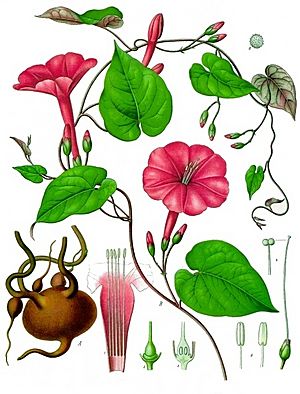John the Conqueror facts for kids
John the Conqueror, also known as High John de Conqueror, is a famous folk hero from African-American stories. He is linked to the roots of a plant called Ipomoea purga, often known as the John the Conqueror root. People in American folklore, especially in the hoodoo tradition, believe these roots have magical powers. Famous blues musician Muddy Waters even sang about him in his songs "Mannish Boy" and "I'm Your Hoochie Coochie Man".
Contents
Who is John the Conqueror?
Sometimes, John is described as an African prince who rode a giant crow named "Old Familiar." He was brought to the Americas as a slave. Even though he was enslaved, his spirit was never broken. He became a folk hero because he was very clever. He used tricks to outsmart those who tried to trick him. He's a bit like Br'er Rabbit from the Uncle Remus stories, who also uses his wits to win.
The famous writer Zora Neale Hurston wrote about John's adventures in her book The Sanctified Church. She called him "High John de Conquer."
John and the Devil's Daughter
One popular story tells how John fell in love with the Devil's daughter. The Devil gave John some impossible tasks. For example, John had to clear a huge amount of land (about 25 hectares) in half a day. Then, he had to plant corn and harvest it all in the other half of the day!
But the Devil's daughter helped John. She gave him a magical axe and plow to get the tasks done. She warned John that her father still planned to kill him. So, John and the Devil's daughter stole the Devil's horses. The Devil chased them, but they escaped by changing their shapes.
John's Lasting Power
Zora Neale Hurston wrote that John the Conqueror is like King Arthur of England. He served his people and is not truly gone. He waits to return when his people need him again.
Hurston explained that High John de Conquer went back to Africa. But he left his power behind in the root of a certain plant. If someone has that root, they can call on his power anytime.
During World War II, Hurston wrote about John to give people hope. She said that John the Conqueror gives courage and laughter. He reminds people that even when things look bad, those who try to oppress others will face worse.
The John the Conqueror Root
The root known as High John the Conqueror or John the Conqueror root comes from the Ipomoea jalapa plant. This plant is also called Ipomoea purga. It's a type of Ipomoea plant, related to morning glories and sweet potatoes. Some people call it bindweed or jalap root.
The root has a pleasant, earthy smell. If you eat it, it acts as a strong laxative, but people don't use it for that in folk magic. Instead, it's often used as part of a mojo bag. It's thought to bring good luck, especially for gambling.
For the root to work as a special charm or amulet, it's important that it is whole and not damaged. Smaller pieces or chips of the dried root are used to make special oils and washes for other kinds of spells.
Other Related Herbs
Other roots are also part of these old legends.
Low John
Low John is the root of the trillium plant, also known as wake-robin (Trillium grandiflorum). People carry it to help with family matters. It's also called Dixie John or Southern John. It's even used to make a hoodoo oil called Dixie Love Oil.
Chewing John
Chewing John is galangal (Alpinia galanga), which is part of the ginger family. People chew it, much like chewing tobacco, to make their breath smell nice and to calm their stomachs. There's a belief that if you spit the juice from chewing this root onto the floor of a courtroom before the judge arrives, you will win your case. This root is also known as Little John and Little John to Chew. In the Deep South, it's sometimes called "Low John."


